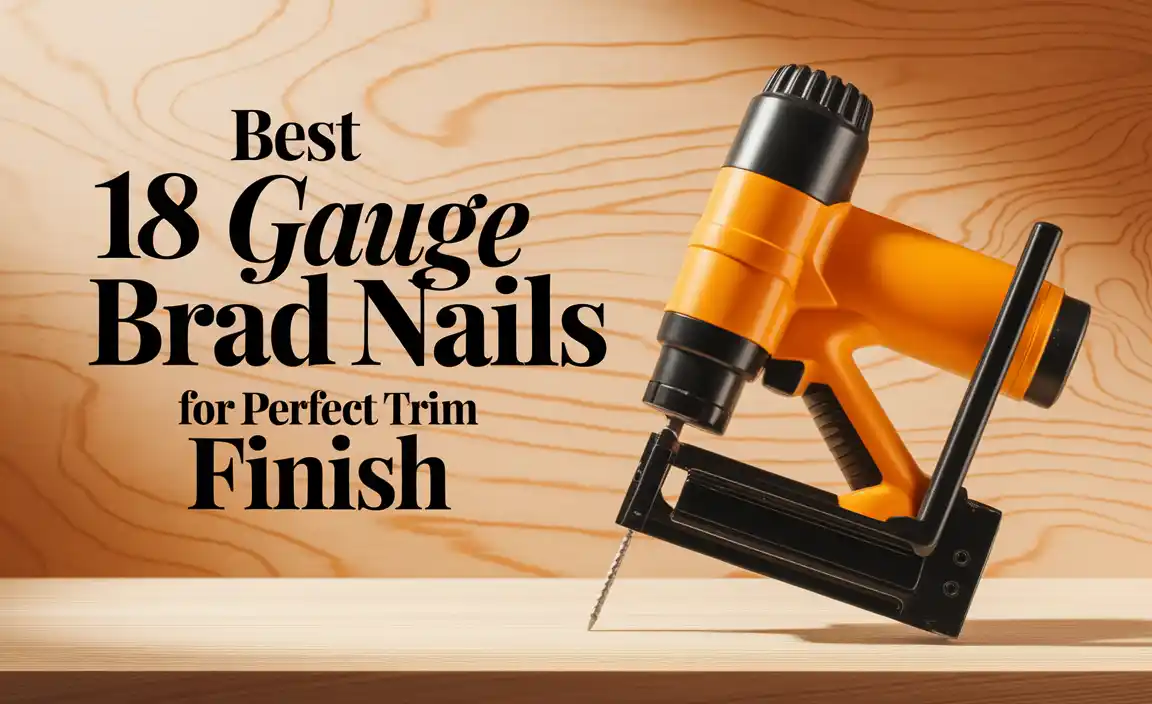Pneumatic framing nailer vs cordless: For most DIYers, a cordless framing nailer offers better portability and ease of use, while pneumatic nailers provide more consistent power and are often more budget-friendly for frequent use. The “best” choice depends on your project needs, budget, and how often you’ll be using it.
So, you’re ready to build something awesome! Maybe it’s a deck, a shed, or even a small addition to your home. You’ve heard about framing nailers, and they sound like a game-changer for getting the job done fast. But then you see there are two main types: pneumatic and cordless. Which one is right for you? It’s a common question, and it can feel a little overwhelming with all the tech specs out there. Don’t worry, I’m here to help you break it all down. We’ll look at what makes each type tick, their pros and cons, and how to pick the perfect nailer for your next big project.
Table of Contents
Understanding the Basics: What is a Framing Nailer?
Before we dive into the differences, let’s talk about what a framing nailer actually does. Think of it as a super-powered hammer that drives nails quickly and efficiently. Instead of swinging a hammer repeatedly, you just pull the trigger, and thwack! – a nail is sunk deep into the wood, securing your framing lumber. This speeds up framing projects immensely, making them much less physically demanding and far more accurate. They’re designed for driving larger nails (usually 2 to 3.5 inches long) needed for structural work.
The Two Main Contenders: Pneumatic vs. Cordless
The core difference between pneumatic and cordless framing nailers lies in how they get their power to drive nails.
Pneumatic Framing Nailers: These are the workhorses you often see on professional construction sites. They use compressed air to drive the nail.
Cordless Framing Nailers: These run on batteries, often with a small fuel cell or gas cartridge that helps ignite and power the drive mechanism.
Let’s explore each one in more detail.
Pneumatic Framing Nailers: The Classic Powerhouse
Pneumatic framing nailers have been around for a long time, and for good reason. They are incredibly reliable and powerful. The “pneumatic” part means they use air pressure. This air is stored in an air tank (called a compressor) and then sent through a hose to the nailer. When you pull the trigger, a burst of compressed air slams down a piston, which drives the nail into the wood.
To use a pneumatic nailer, you’ll always need an air compressor, a suitable air hose, and a way to power the compressor (usually plugged into an electrical outlet). This might sound like a lot of gear, but it’s a tried-and-true system that many builders swear by.
Pros of Pneumatic Framing Nailers:
Consistent Power: They deliver a strong, consistent nail depth every time because the air pressure is steady. This means fewer “nail pops” or under-driven nails.
Lighter Tool Weight: The nailer itself is usually lighter because the motor and any power source aren’t built into the tool. The bulk of the power comes from the compressor.
Durability and Longevity: Pneumatic tools are often built to last and can withstand heavy daily use. They tend to have fewer complex internal parts that can break down.
Lower Initial Tool Cost: Often, the nailer itself is less expensive than its cordless counterpart.
No Recharge/Refuel Downtime: As long as your compressor has air, you can keep firing nails. No waiting for batteries to charge.
Ideal for High-Volume Work: If you’re framing an entire house, a pneumatic nailer can keep up the pace without issues.
Cons of Pneumatic Framing Nailers:
Requires Additional Equipment: You absolutely need an air compressor and an air hose. This adds to the overall cost and bulk of your setup.
Limited Portability: Working with a hose restricts your movement. You can’t just grab it and go build something across the yard without dragging the compressor.
Noise Levels: Air compressors and pneumatic nailers can be quite loud, often requiring hearing protection.
Setup and Takedown: You need to connect the hose, ensure the compressor is running, and then disconnect and store everything afterwards.
Air Leaks: Hoses and fittings can sometimes develop leaks, reducing efficiency.
Cordless Framing Nailers: The Freedom Fighters
Cordless framing nailers are the newer technology, offering incredible convenience and freedom. These tools run on batteries – similar to those used in other cordless power tools. Some cordless models also use a small canister of compressed gas (like propane) that ignites with a spark to power the nail drive. Others rely solely on battery power for both the motor and the nailer’s mechanism.
The biggest draw here is the “cordless” aspect. No hoses, no compressors. You just grab the tool, pop in a charged battery (and sometimes a gas canister), and you’re ready to go anywhere.
You can find two main types of cordless framing nailers:
Battery-Powered Only: These use a powerful electric motor and battery to drive the nail. They are becoming increasingly efficient and powerful.
Battery and Fuel Cell Powered: These combine a battery (usually for the fan and ignition) with a disposable fuel cell. The fuel cell vaporizes and is ignited by a spark plug, creating a small explosion that drives the piston.
Pros of Cordless Framing Nailers:
Unmatched Portability: This is the killer feature. No hoses, compressors, or cords means you can move freely around your job site, up ladders, and into tight spaces with ease.
Quick Setup: Grab it, ensure the battery is charged, and you’re ready to nail in seconds.
Cleaner Work Area: Fewer components mean less clutter and easier cleanup.
Quieter Operation: While still noisy, battery-powered models are generally quieter than pneumatic systems.
Modern Features: Many cordless models offer features like depth adjustment on the fly, tool-free jam clearing, and LED work lights.
Excellent for Smaller Jobs and DIY: Perfect for homeowners, hobbyists, and those who don’t need to frame entire houses regularly.
Cons of Cordless Framing Nailers:
Battery Management: You need charged batteries. If you run out mid-project, you’re out of commission until they recharge or you swap them. This often means buying extra expensive batteries.
Fuel Cell Dependency (for some models): If your model uses fuel cells, you need to keep a supply on hand, which is an ongoing cost.
Heavier Tool Weight: The battery, motor, and sometimes gas mechanism are all integrated into the tool, making them heavier than pneumatic nailers.
Higher Initial Tool Cost: Cordless framing nailers are typically more expensive upfront, especially when you factor in the cost of batteries and chargers.
Power Consistency (can vary): While improving rapidly, some battery-powered models might not deliver the same consistent depth as high-powered pneumatics, especially with dense hardwoods or when the battery is low. Fuel cell models generally offer more consistent power.
Maintenance: Fuel cell models have spark plugs and other components that may require occasional cleaning or replacement.
Key Features to Compare: What Matters for You?
When you’re weighing up pneumatic vs. cordless, think about these important features:
Power Source & Runtime
Pneumatic: Air compressor. Runtime limited by compressor tank size and how quickly it can refill.
Cordless: Battery (typically 18V or 20V MAX systems, though some use higher voltage). Runtime varies greatly by battery size (Ah rating) and tool efficiency. Fuel cell models have runtime dependent on the fuel cell’s lifespan (e.g., you get X nails per canister).
Weight & Ergonomics
Pneumatic: Lighter nailer, but you’re also carrying a hose and a compressor (if not fixed). Total system weight is higher.
Cordless: Heavier tool itself, but no extra gear to lug around for mobility. Ergonomics can be a big selling point for comfort during extended use.
Cost (Initial & Ongoing)
Pneumatic: Lower initial cost for the nailer, but you must factor in the air compressor, hose, and potentially air filters. Ongoing costs are minimal aside from electricity.
Cordless: Higher initial cost for the nailer, battery, and charger. If using fuel cell models, there’s a recurring cost for fuel canisters. High-capacity batteries are also an investment.
Project Type & Frequency
Pneumatic: Best for large, continuous projects where portability isn’t the main concern, or for professional use where consistent power and durability are paramount.
Cordless: Ideal for smaller to medium DIY projects, renovations, or any job where you need to move around a lot, work at heights, or don’t want to deal with compressors and hoses.
Noise & Vibration
Pneumatic: Generally louder due to the compressor and air release. Vibration can be noticeable.
* Cordless: Quieter than pneumatic (especially battery-only models), but can still have significant vibration. Fuel cell models tend to have more “kick.”
Side-by-Side Comparison: Pneumatic Framing Nailer vs. Cordless
To make things even clearer, here’s a table summarizing the key differences:
| Feature | Pneumatic Framing Nailer | Cordless Framing Nailer |
| :—————- | :———————————————————- | :———————————————————- |
| Power Source | Compressed air from an air compressor | Rechargeable battery (and optional fuel cell) |
| Portability | Limited by hose length and compressor location | High (no hoses or compressors needed) |
| Initial Cost | Lower for nailer; higher for compressor/hose | Higher for nailer, battery, and charger |
| Ongoing Cost | Minimal (electricity) | Moderate (electricity for charging, fuel cells if applicable) |
| Weight | Lighter tool; heavier overall system | Heavier tool; lighter overall system |
| Power Output | Very consistent, high power | Good to excellent, improving but can vary (esp. battery-only) |
| Runtime | Limited by compressor tank/refill rate | Limited by battery charge/fuel cell life |
| Setup Time | Longer (compressor, hose connection) | Very short (insert battery) |
| Noise Level | High (compressor + nailer) | Moderate (nailer only, quieter for battery-only) |
| Ideal For | Large projects, professional use, workshops, budget pro | DIY, renovations, portability needs, mobile work |
| Maintenance | Compressor maintenance, air filter changes | Battery care, fuel cell replacement (if applicable) |
Choosing the Right Nailer for Your Project
Let’s break down how your specific needs should guide your decision.
For the DIY Homeowner Tackling Weekend Projects
If you’re building a backyard pergola, adding a fence, or tackling a few home improvement projects each year, convenience and ease of use are probably your top priorities. In this scenario, a cordless framing nailer is often the way to go.
You won’t have to invest in a bulky air compressor and hose. You can grab the nailer and get straight to work. Most modern cordless framing nailers are powerful enough for typical DIY lumber sizes. Just remember to keep your batteries charged!
Consider battery-powered models from reputable brands that use platforms you might already own (like DEWALT 20V MAX or Milwaukee M18 batteries). This can save you money if you already own other tools in that battery system.
For the Serious Hobbyist or Woodworker
If you’re spending significant time in your workshop on framing projects, custom-built furniture with substantial frames, or even building small structures, the decision gets a little more nuanced.
- Consider Pneumatic if: You have a dedicated workshop space where a compressor won’t be an issue, you frequently frame large projects, and you want the absolute most consistent drive and power. The lower tool cost might also be appealing for frequent use. You can often find good deals on used professional-grade pneumatic nailers.
- Consider Cordless if: You value the flexibility to work outside your workshop, you need to move around a large project without dragging hoses, or you prefer a less cluttered workspace. Higher-end cordless models now rival pneumatics in power and consistency.
A good compromise for some might be a high-quality cordless framing nailer with excellent battery life, used alongside a smaller, portable air compressor for tasks where pneumatics are still superior or when batteries need charging.
For the Budget-Conscious Builder
Budget is a major factor for many. Let’s look at the real costs:
- Pneumatic Entry: A basic pancake air compressor might cost $100-$200. A decent pneumatic framing nailer can be found for $100-$250. A 25ft or 50ft hose is another $30-$60. So, entry is around $230-$510.
- Cordless Entry: A good cordless framing nailer often starts at $250-$400. This usually includes one battery and a charger. If you need more batteries, each can add $50-$150. Some fuel cell kits are in the $250-$450 range, but you then have ongoing fuel costs ($7-$10 per canister, yielding 1,000-1,200 nails).
While the upfront tool cost for cordless can be similar or higher, the lack of compressor and hose simplifies things and reduces total equipment costs if you’re just starting out. However, for heavy, frequent framing, the long-term operating costs of pneumatic (electricity vs. fuel cells/batteries) might favor pneumatic, assuming your compressor is already owned or a good deal can be found.
Tips for Using Your New Framing Nailer Safely
No matter which type you choose, safety is absolutely paramount when using a framing nailer. These tools drive nails with significant force.
- Always Wear Safety Glasses: This is non-negotiable. Flying debris or ricocheting nails can cause serious eye injury. Consider a full face shield for extra protection.
- Read the Manual: Every nailer is different. Familiarize yourself with its specific features, safety mechanisms, and operating procedures. The Occupational Safety and Health Administration (OSHA) provides guidelines on the importance of proper tool usage and personal protective equipment (PPE).
- Understand Sequential vs. Contact Fire Modes: Most framing nailers have two modes:
- Sequential Fire (Safety Mode): You must press the nose of the nailer against the wood (contact trip) and then pull the trigger to fire a nail. This prevents accidental firing.
- Contact Fire (Bump Fire): As long as the trigger is held down, the nailer will fire a nail every time the nose contacts the wood. This is faster but much less safe. Only use this mode if you are experienced and fully understand the risks. For most DIYers, sequential fire is the recommended and safer option.
- Never Point the Nailer at Yourself or Others: Treat it like a loaded firearm. Always keep the muzzle pointed in a safe direction.
- Be Aware of Your Workpiece: Ensure the nail will go into solid material and not through to the other side where someone might be. Check for hidden electrical wires or plumbing within the material you are nailing into.
- Disconnect Power When Not in Use: For pneumatic, disconnect the air hose. For cordless, remove the battery. This prevents accidental firing.
- Handle Jams Carefully: If a nail jams, disconnect the power source before attempting to clear it. Refer to your manual for specific jam-clearing instructions.
Frequently Asked Questions (FAQ)
Q1: Can I use a cordless framing nailer for framing an entire house?
A1: While cordless framing nailers are becoming more powerful, they are generally best suited for smaller to medium-sized projects. For framing an entire house, a pneumatic system is often more efficient and cost-effective in the long run due to consistent power, faster operation without battery swaps, and lower initial tool cost.
Q2: How many nails can I get from a single battery charge on a cordless framing nailer?
A2: This varies significantly based on the battery’s capacity (Ah rating), the nailer’s efficiency, the type of wood you’re nailing into, and the depth of the nails. A typical 4.0Ah or 5.0Ah battery might drive anywhere from 300 to 800 nails on a single charge. It’s always a good idea to have a spare charged battery on hand.
Q3: Is a pneumatic framing nailer too loud for a DIYer?
A3: Pneumatic nailers, combined with the compressor, are quite loud. However, with proper hearing protection (like ear


